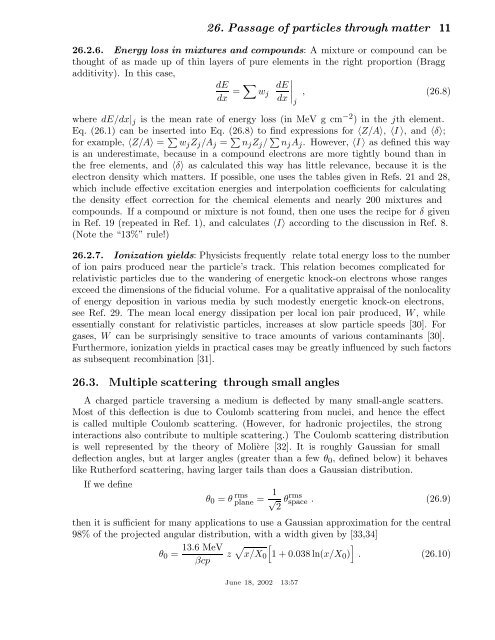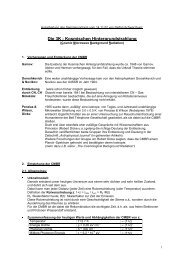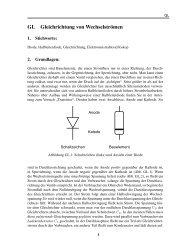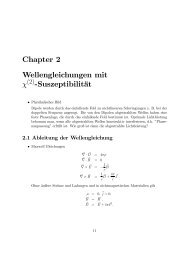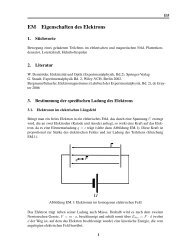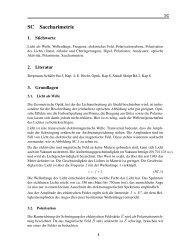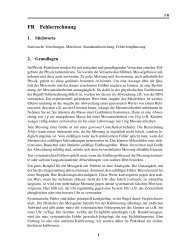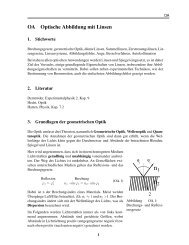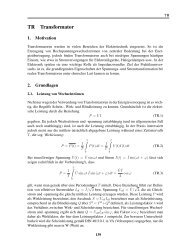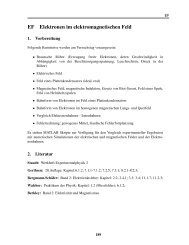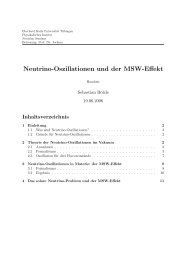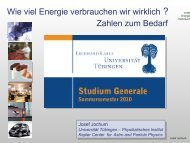26. passage of particles through matter - Particle Data Group
26. passage of particles through matter - Particle Data Group
26. passage of particles through matter - Particle Data Group
Create successful ePaper yourself
Turn your PDF publications into a flip-book with our unique Google optimized e-Paper software.
<strong>26.</strong> Passage <strong>of</strong> <strong>particles</strong> <strong>through</strong> <strong>matter</strong> 11<br />
<strong>26.</strong>2.6. Energy loss in mixtures and compounds: A mixture or compound can be<br />
thought <strong>of</strong> as made up <strong>of</strong> thin layers <strong>of</strong> pure elements in the right proportion (Bragg<br />
additivity). In this case,<br />
dE<br />
dx = ∑ w j<br />
dE<br />
dx<br />
∣ , (<strong>26.</strong>8)<br />
j<br />
where dE/dx| j isthemeanrate<strong>of</strong>energyloss(inMeVgcm −2 )inthejth element.<br />
Eq. (<strong>26.</strong>1) can be inserted into Eq. (<strong>26.</strong>8) to find expressions for 〈Z/A〉, 〈I 〉, and〈δ〉;<br />
for example, 〈Z/A〉 = ∑ w j Z j /A j = ∑ n j Z j / ∑ n j A j . However, 〈I 〉 as defined this way<br />
is an underestimate, because in a compound electrons are more tightly bound than in<br />
the free elements, and 〈δ〉 as calculated this way has little relevance, because it is the<br />
electron density which <strong>matter</strong>s. If possible, one uses the tables given in Refs. 21 and 28,<br />
which include effective excitation energies and interpolation coefficients for calculating<br />
the density effect correction for the chemical elements and nearly 200 mixtures and<br />
compounds. If a compound or mixture is not found, then one uses the recipe for δ given<br />
in Ref. 19 (repeated in Ref. 1), and calculates 〈I〉 according to the discussion in Ref. 8.<br />
(Note the “13%” rule!)<br />
<strong>26.</strong>2.7. Ionization yields: Physicists frequently relate total energy loss to the number<br />
<strong>of</strong> ion pairs produced near the particle’s track. This relation becomes complicated for<br />
relativistic <strong>particles</strong> due to the wandering <strong>of</strong> energetic knock-on electrons whose ranges<br />
exceed the dimensions <strong>of</strong> the fiducial volume. For a qualitative appraisal <strong>of</strong> the nonlocality<br />
<strong>of</strong> energy deposition in various media by such modestly energetic knock-on electrons,<br />
see Ref. 29. The mean local energy dissipation per local ion pair produced, W , while<br />
essentially constant for relativistic <strong>particles</strong>, increases at slow particle speeds [30]. For<br />
gases, W can be surprisingly sensitive to trace amounts <strong>of</strong> various contaminants [30].<br />
Furthermore, ionization yields in practical cases may be greatly influenced by such factors<br />
as subsequent recombination [31].<br />
<strong>26.</strong>3. Multiple scattering <strong>through</strong> small angles<br />
A charged particle traversing a medium is deflected by many small-angle scatters.<br />
Most <strong>of</strong> this deflection is due to Coulomb scattering from nuclei, and hence the effect<br />
is called multiple Coulomb scattering. (However, for hadronic projectiles, the strong<br />
interactions also contribute to multiple scattering.) The Coulomb scattering distribution<br />
is well represented by the theory <strong>of</strong> Molière [32]. It is roughly Gaussian for small<br />
deflection angles, but at larger angles (greater than a few θ 0 , defined below) it behaves<br />
like Rutherford scattering, having larger tails than does a Gaussian distribution.<br />
If we define<br />
θ 0 = θ rms<br />
plane =<br />
1 √<br />
2<br />
θ rms<br />
space . (<strong>26.</strong>9)<br />
then it is sufficient for many applications to use a Gaussian approximation for the central<br />
98% <strong>of</strong> the projected angular distribution, with a width given by [33,34]<br />
13.6 MeV<br />
θ 0 = z √ ]<br />
x/X 0<br />
[1+0.038 ln(x/X 0 ) . (<strong>26.</strong>10)<br />
βcp<br />
June 18, 2002 13:57


